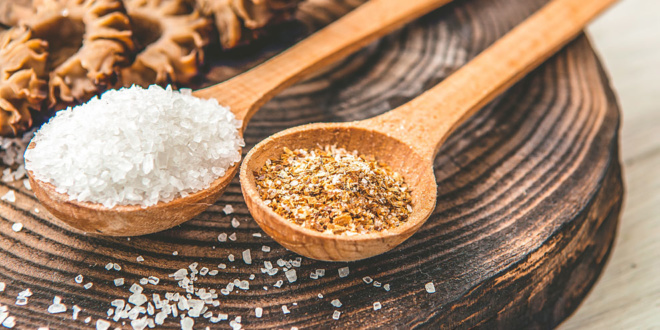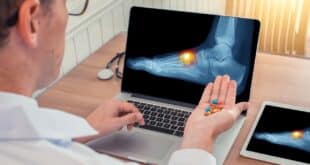Too Much Sodium
Sodium is required in our bodies for a variety of functions. For example, it helps us to regulate fluids in our cells and transmit nerve messages, and helps our muscles to contract. Here in the United States, experts recommend that we need no less than 500 milligrams but we consume much more than this. Some of us consume 10,000 to 12,000 milligrams a day. Is this too much? Researchers and nutritionists think so.1
Some individuals are sensitive to too much sodium in their bodies and sensitivity increases as we age. Too much of it has been connected to increasing the pressure in their blood vessels and this increases the risk for heart disease. Health experts recommend that these individuals should limit their sodium intake to about 2,300 milligrams of sodium, which is the amount found in a teaspoon of salt.
Health experts are also discovering that too much sodium may also increase the risk of heart disease. This is true even among those whose blood pressure is not sensitive to salt. In a study published last year, researchers reviewed data from two randomized trials. They examined the sodium intake of adults aged 30 – 54 years old who had a high normal blood pressure. High normal would be 80 – 89 mm Hg diastolic – the bottom number and less than 140 mm Hg for the systolic or top number of the blood pressure reading. They learned that reducing sodium intake reduces blood pressure in sodium sensitive individuals but may also lower the risk of stroke and cardiovascular disease.2
Lowering Sodium
Lowering our sodium intake has been somewhat difficult because sodium is found in so many foods. We’ve been asked by health experts to avoiding adding salt before tasting foods but added salt is not our largest sodium source. Prepared foods such as soups, luncheon meats, hot dogs, pickles, bacon, olives, smoked meat or fish, salted nuts, some cheeses, many different snack foods and gravies and sauces provide much of our dietary sodium.
The American Medical Association is taking our sodium intake seriously. In 2006, the organization asked the U.S. government to remove the salt from the “Generally Recognized as Safe” (GRAS) food and ingredient list. They have also asked the food industry to cut back on sodium in prepared foods but little progress has been made.3
What Can We Do?
So if companies will not collectively lower sodium in prepared products, what can we do to lower our sodium intake?
Read labels. Prepared foods include the sodium content per serving under the, “Nutrition Facts” section of the label. If a product has over 500 milligrams of sodium, then the food is a high sodium food and should be avoided or drastically reduced in the diet.
Consume foods that are low sodium or sodium free. Low sodium foods are those that contain 140 mg sodium or less per serving. Sodium free foods are those that contain 5 mg sodium or less. Foods such as fruits, most vegetables, home-prepared grains and cereals and low-sodium foods should make up most of the diet.
Cook with little or no salt, soy sauce and MSG. Instead of grabbing the salt shaker, add other herbs and spices to foods. Onion, garlic, bell pepper and celery are great seasonings and garlic has been studied for its pressure lowering properties. Other common spices used in cooking are thyme, basil, oregano, parsley and pepper. Here are a few other ideas that may satisfy the desire for flavorful foods.4
Spices to Flavor Food
Cardamom – Mellow flavor, sharply bitter and strong, but is warm. Used in sweet and savory dishes. Used in curry, pastries, cakes, breads puddings and ice creams; and hot drinks.
Cinnamon – Sweet, warm, woody aroma and flavor can be delicate or intense. Can be used in sweet and savory dishes. Good in meat and protein dishes, grains such as rice with raisins, desserts, cakes and drinks.
Cloves – Dark aroma that is warm, strong and rich. In large amounts, it can leave a numbing sensation in mouth. Used in sweet foods, breads, pies, cookies and other foods that may have a slight sweet taste.
Coriander – Strong fetid smell. Taste is mild. Used in meat, bean and protein dishes, stews, pickles and in baking desserts. Used in curry.
Cumin – Heavy, strong with acrid or warm flavors. Pungent. Used in curries, stews and in minced meats. It is an ingredient in chili con carne. Can be used to protein, bean and vegetable dishes.
Ginger – Warm taste with a woody, sweet and rich undertone. Used with garlic in stir fried rice and vegetables; great in dressings. Used in desserts, cakes and pickles. Also used in curry.
Lemon Grass – Lemon like flavor. Used in Southeast Asian cooking. Also used in soups and stews. Works well with garlic, shallots and chili.
Nutmeg & Mace – Rich aroma. Warm taste and highly aromatic. Nutmeg is sweetish while mace is sweetish but slightly bitter.
Sesame – Mild tasting and sweet; nutty flavor when roasted. Used in breads, cakes, candies, rice, salads and vegetables. The oil can make flavorful salad dressings.
Turmeric – Lightly aromatic but taste is pungent and musky. Used in curries and south Asian dishes. Used in Indian bean and lentil dishes.
A Healthy Start
If we want to live healthy lives, limiting our sodium intake at a low to moderate level is important. And don’t forget to keep physically active, drink plenty of water and make healthy food choices. These are basic ingredients for good health and a healthy heart.
Pamela A. Williams writes from Southern California.
If you liked this, you may also like Need to Limit Your Sodium?
1 Whitney, EN, Cataldo, CB and Rolfes, SR. Understanding Normal and Clinical Nutrition, Sixth Edition. Wadsworth: Thomson Learning; 2002.
2 Cook, NR, et al. "Long term effects of dietary sodium reduction on cardiovascular disease outcomes: observational follow-up of the trials of hypertension prevention" (TOHP). BMJ, doi:10.1136/bmj.39147.604896.55 (published 20 April 2007)
3 Press Release. AMA calls for measures to reduce sodium intake in U.S. diet. accessed 01/02/08.
4 Norman, Jill. The Complete Book of Spices: A practical guide to spices and aromatic seeds. Dorling Kindersley Limited, 1990.
 Answers for Me Support & encouragement for every-day life
Answers for Me Support & encouragement for every-day life



